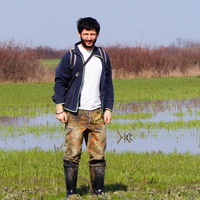Research Interests:
Until recently, owing to the accelerated development within the peri-urban areas, the mapped butmostly the unmapped archaeological heritage was subjected to continuous destruction. Most of the alreadyaffected archaeological sites were... more
Until recently, owing to the accelerated development within the peri-urban areas, the mapped butmostly the unmapped archaeological heritage was subjected to continuous destruction. Most of the alreadyaffected archaeological sites were entirely unknown, given the absence of thorough fieldwork in regions withhigh urban development rates. Unfortunately, such comprehensive site repertories are still lacking in Romania.Considering this but also the urgency for new urbanistic plans determined the local authorities to resort toarchaeological studies in the process of urban expansion. This paper is therefore based on a field survey report onthe urban development of Sânicolau Mare, a city situated within the boundaries of Timiș County, southwestern Romania.
Research Interests: Archaeology, Geology, Geomorphology, Geophysics, Ground Penetrating Radar (GPR), and 15 moreLandscape Archaeology, Medieval Studies, Medieval Church History, Medieval Archaeology, Archaeological Prospection, Surveying, Magnetic field, Romania, ERT, ELECTRICAL RESISTIVITY TOMOGRAPHY, Magnetometry, Medeival Studies, Geographic Information Systems (GIS), Near surface gephysics, and Castles of Medieval Hungarian Kingdom
This study presents a new way to reconstruct the extent of medieval archaeological sites by using approaches from the field of geoinformatics. Hence, we propose a combined use of non-invasive methodologies which are used for the first... more
This study presents a new way to reconstruct the extent of medieval archaeological sites by using approaches from the field of geoinformatics. Hence, we propose a combined use of non-invasive methodologies which are used for the first time to study a medieval village in Romania. The focus here will be on ground-based and satellite remote-sensing techniques. The method relies on computing vegetation indices (proxies), which have been utilized for archaeological site detection in order to detect the layout of a deserted medieval town located in southwestern Romania. The data were produced by a group of small satellites (3U CubeSats) dispatched by Planet Labs which delivered high-resolution images of the Earth’s surface. The globe is encompassed by more than 150 satellites (dimensions: 10 × 10 × 30 cm) which catch different images for the same area at moderately short intervals at a spatial resolution of 3–4 m. The four-band Planet Scope satellite images were employed to calculate a nu...
Research Interests: Geography, Geophysics, Computer Science, Remote Sensing, Medieval History, and 8 moreMedieval Studies, Medieval Archaeology, Satellite remote sensing, Remote sensing and GIS applications in Landscape Research, Medieval Hungary, Deserted Medieval Villages, History of Banat, and Normalized Difference Vegetation Index
Until recently, the Late Iron Age was virtually unknown in the lowland Banat, but new research has shed new light on this forgotten era. Nonetheless, the discoveries from this time continue to raise many questions. This study aims to... more
Until recently, the Late Iron Age was virtually unknown in the lowland Banat, but new research has shed new light on this forgotten era. Nonetheless, the discoveries from this time continue to raise many questions. This study aims to recreate the ancient habitat of a small area of the historic Banat riverscape that grew up around the Dacian fortification known as Unip-Dealu Cetățuica. Traditional and cutting-edge methods alike have been used to map human settlements and study the local paleohydrology. 14 sites dating from the Late Iron Age were discovered over 6000 hectares during the systematic field survey. The core drilling procedure was based on the analysis of the existing LiDAR scans of the entire area. Using the optically stimulated luminescence (OSL) method, we could calculate the absolute age and activity period of the river throughout five generations. The results facilitated a closer examination of the relationship between settlement topography and the dynamics of water bodies, indicating preferences or trends in how human communities chose the location for their settlements. Future geophysical investigations and invasive research can improve the overall accuracy of the results.
Research Interests:
To understand the functioning of fluvial systems it is important to investigate dynamics of sediment transport and the source of sediments. In case of reconstructing past processes these studies must be accompanied by the numerical dating... more
To understand the functioning of fluvial systems it is important to investigate dynamics of sediment transport and the source of sediments. In case of reconstructing past processes these studies must be accompanied by the numerical dating of sediment samples. In this respect optically stimulated luminescence is a widely used technique, by which the time of sediment deposition can be directly dated. Recently, in various fluvial environments it has been shown that certain luminescence properties of minerals, and especially that of quartz, can be applied as indicators of fluvial erosion and/or sediment provenance. These properties are residual luminescence (or residual dose) and luminescence sensitivity of quartz grains. However, the values of the parameters above are affected by various factors, the importance of which is under debate. The present study therefore aims to assess these factors along a ~560 km long reach of River Mureş (Maros) a relatively large river with a compound sur...
